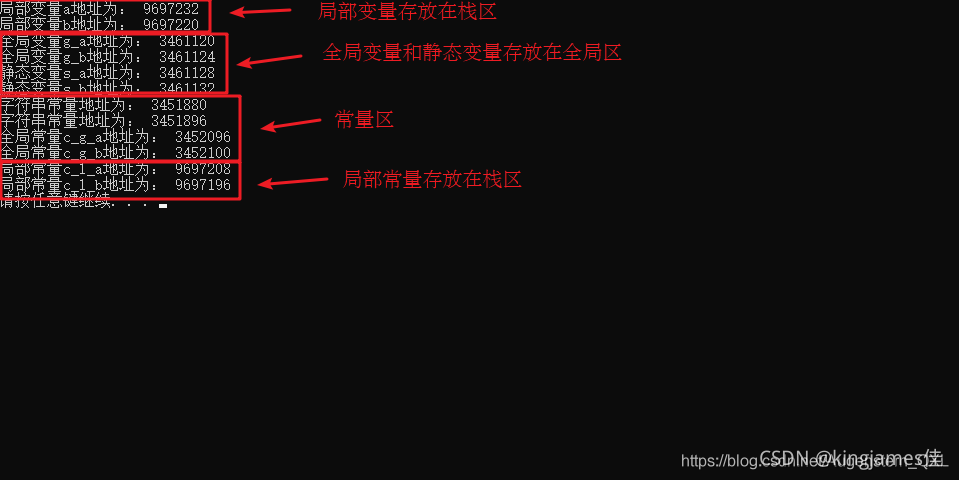1内存分区模型
C++程序在执行时,将内存大方向划分为4个区域
- 代码区:存放函数体的二进制代码,由操作系统进行管理的
- 全局区:存放全局变量和静态变量以及常量
- 栈区:由编译器自动分配释放, 存放函数的参数值,局部变量等
- 堆区:由程序员分配和释放,若程序员不释放,程序结束时由操作系统回收
内存四区意义:不同区域存放的数据,赋予不同的生命周期, 给我们更大的灵活编程
1.1程序运行以前
在程序编译后,生成了exe可执行程序,未执行该程序前分为两个区域。
- 代码区:
? 存放 CPU 执行的机器指令
? 代码区是共享的,共享的目的是对于频繁被执行的程序,只需要在内存中有一份代码即可
? 代码区是只读的,使其只读的原因是防止程序意外地修改了它的指令 - 全局区:
? 全局变量和静态变量.常量存放在此
? 常量区包含了字符串常量和const修饰的全局常量
? 该区域的数据在程序结束后由操作系统释放.
eg:
//全局变量
int g_a = 10;
int g_b = 10;
//全局常量
const int c_g_a = 10;
const int c_g_b = 10;
int main() {
//局部变量
int a = 10;
int b = 10;
//打印地址
cout << "局部变量a地址为: " << (int)&a << endl;
cout << "局部变量b地址为: " << (int)&b << endl;
cout << "全局变量g_a地址为: " << (int)&g_a << endl;
cout << "全局变量g_b地址为: " << (int)&g_b << endl;
//静态变量
static int s_a = 10;
static int s_b = 10;
cout << "静态变量s_a地址为: " << (int)&s_a << endl;
cout << "静态变量s_b地址为: " << (int)&s_b << endl;
cout << "字符串常量地址为: " << (int)&"hello world" << endl;
cout << "字符串常量地址为: " << (int)&"hello world1" << endl;
cout << "全局常量c_g_a地址为: " << (int)&c_g_a << endl;
cout << "全局常量c_g_b地址为: " << (int)&c_g_b << endl;
const int c_l_a = 10;
const int c_l_b = 10;
cout << "局部常量c_l_a地址为: " << (int)&c_l_a << endl;
cout << "局部常量c_l_b地址为: " << (int)&c_l_b << endl;
system("pause");
return 0;
}

1.2程序运行后
- 栈区:
? 由编译器自动分配释放, 存放函数的参数值,局部变量等
[?注]:不要返回局部变量的地址,栈区开辟的数据由编译器自动释放
int * func()
{
int a = 10;
return &a;
}
int main() {
int *p = func();
cout << *p << endl;//第一次会输出a=10,因为编译器会自动储存一次局部变量的值
cout << *p << endl;//第二次输出的是乱码,因为编译器自动释放了局部变量的值
system("pause");
return 0;
}
- 堆区:
由程序员分配释放,若程序员不释放,程序结束时由操作系统回收
?在C++中主要利用new关键字在堆区开辟内存
int* func()
{
int* a = new int(10);
return a;
}
int main() {
int *p = func();
cout << *p << endl;
cout << *p << endl;//一直输出p=10
system("pause");
return 0;
}
1.3new操作符
C++中利用new操作符在堆区开辟数据
堆区开辟的数据,由程序员手动开辟,手动释放,释放利用操作符 delete
? 语法:new 数据类型
? 利用new创建的数据,会返回该数据对应的类型的指针
//基本语法
int* func()
{
// 在堆区创建整型数据
// new 返回的是该数据类型的指针
int* a = new int(10);
return a;
}
int main() {
int *p = func();
cout << *p << endl;
cout << *p << endl;
//利用delete释放堆区数据
delete p;
//cout << *p << endl; //报错,释放的空间不可访问
system("pause");
return 0;
}
//堆区开辟数组
int main() {
int* arr = new int[10];
for (int i = 0; i < 10; i++)
{
arr[i] = i + 100;
}
for (int i = 0; i < 10; i++)
{
cout << arr[i] << endl;
}
//释放数组 delete 后加 []
delete[] arr;
system("pause");
return 0;
}
2 引用
2.1引用的本质和基本语法
本质:引用的本质在c++内部实现是一个指针常量
作用: 给变量起别名,
语法:数据类型 &别名 = 原名
int main() {
int a = 10;
int &b = a;//对b操作和对变量a操作就等同了
cout << "a = " << a << endl;
cout << "b = " << b << endl;
// 10
// 10
b = 100;
cout << "a = " << a << endl;
cout << "b = " << b << endl;
// 100
// 100
system("pause");
return 0;
}
[注]:
- &(引用)==>用来传值,出现在变量声明语句中位于变量 左边时,表示声明的是引用.
- &(取地址运算符)==>用来获取首地址,在给变量赋初值时出现在等号右边或在执行语句中作为一元运算符出现时表示取对象的地址.
//引用的本质
//发现是引用,转换为 int* const ref = &a;
void func(int& ref){
ref = 100; // ref是引用,转换为*ref = 100
}
int main(){
int a = 10;
//自动转换为 int* const ref = &a; 指针常量是指针指向不可改,也说明为什么引用不可更改
int& ref = a;
ref = 20; //内部发现ref是引用,自动帮我们转换为: *ref = 20;
cout << "a:" << a << endl;
cout << "ref:" << ref << endl;
func(a);
return 0;
}
2.2 引用注意事项
- 引用必须初始化
- 引用在初始化后,不可以改变
int main() {
int a = 10;
int b = 20;
//int &c; //错误,引用必须初始化
int &c = a; //一旦初始化后,就不可以更改
c = b; //这是赋值操作,不是更改引用
cout << "a = " << a << endl;
cout << "b = " << b << endl;
cout << "c = " << c << endl;
// 20
// 20
// 20
system("pause");
return 0;
}
2.3 引用做函数参数
作用:函数传参时,可以利用引用的技术让形参修饰实参
优点:可以简化指针修改实参
//1. 值传递
void mySwap01(int a, int b) {
int temp = a;
a = b;
b = temp;
}
//2. 地址传递
void mySwap02(int* a, int* b) {
int temp = *a;
*a = *b;
*b = temp;
}
//参数:把地址传进去,用指针接收
//3. 引用传递
void mySwap03(int& a, int& b) {
int temp = a;
a = b;
b = temp;
}
//参数:别名,下面的a是上面的a的别名,用别名操作修改可原名操作修改是一样的
int main() {
int a = 10;
int b = 20;
// 值传递,形参不会修饰实参
mySwap01(a, b);
cout << "a:" << a << " b:" << b << endl;
// a:10 b:20
// 地址传递,形参会修饰实参
mySwap02(&a, &b);
cout << "a:" << a << " b:" << b << endl;
// a:20 b:10
// 引用传递,形参会修饰实参
mySwap03(a, b);
cout << "a:" << a << " b:" << b << endl;
// a:10 b:20
system("pause");
return 0;
}
2.4 引用做函数返回值
作用:引用是可以作为函数的返回值存在的
注:不要返回局部变量引用
用法:函数调用作为左值
//返回局部变量引用
//数据类型后加&,相当于用引用的方式返回
int& test01() {
int a = 10; //局部变量存放在栈区
return a;
}
//返回静态变量引用
int& test02() {
// 静态变量存放在全局区,全局区上的数据在程序结束后系统释放
static int a = 20;
return a;
}
int main() {
//不能返回局部变量的引用
//因为局部变量操作完会自动释放
int& ref = test01();
cout << "ref = " << ref << endl;
cout << "ref = " << ref << endl;
// 第一次结果正确,因为编译器做了保留
// 第二次结果错误,因为a的内存已经释放
//如果函数做左值,那么必须返回引用
int& ref2 = test02();
cout << "ref2 = " << ref2 << endl;
cout << "ref2 = " << ref2 << endl;
// 20
// 20
test02() = 1000;
//函数调用在等号的左边存在:函数调用作为左值
cout << "ref2 = " << ref2 << endl;
cout << "ref2 = " << ref2 << endl;
// 1000
// 1000
system("pause");
return 0;
}
2.5 常量引用
作用:常量引用主要用来修饰形参,防止误操作
在函数形参列表中,可以加const修饰形参,防止形参改变实参
//引用使用的场景,通常用来修饰形参
void showValue(const int& v) {
//const加入就不能修改形参
//v += 10;
cout << v << endl;
}
int main() {
//int& ref = 10; 引用本身需要一个合法的内存空间,因此这行错误
//加入const就可以了,编译器优化代码,int temp = 10; const int& ref = temp;
const int& ref = 10;
//ref = 100; //加入const后不可以修改变量
cout << ref << endl;
//函数中利用常量引用防止误操作修改实参
int a = 10;
showValue(a);
system("pause");
return 0;
}